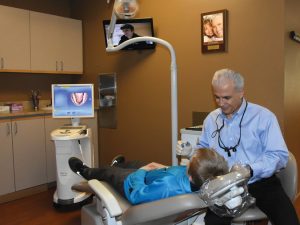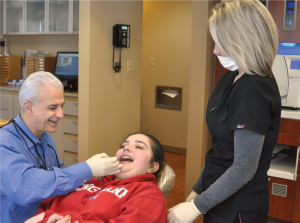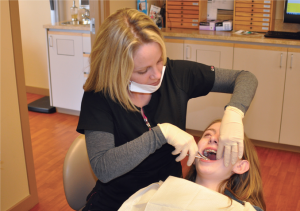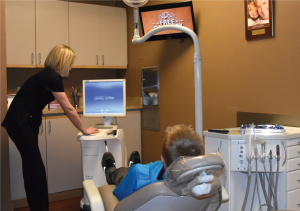Teledontic, Pharyngorofacial Orthopedic Treatment for OSA
Alex was devastated. His best friend Brandon invited him and couple of other friends to go to Disneyland with his family. He and Brandon were inseparable at school, even over the weekends. But Alex was afraid and decided not to go. If he went on the trip and shared one of the double beds in the hotel with Brandon, Alex knew he’d probably wet the bed while sleeping.

Alex’s story has a happy ending. Although he missed the trip to Disneyland, his mom found out through me – I was treating her obstructive sleep apnea (OSA) – that Alex’s problem with bed-wetting is curable. I explained to mom that Alex’s recent diagnosis of ADHD, metabolic syndrome, overweight, high blood pressure, high cholesterol, high blood sugar, and poor school performance, along with snoring and restless sleep, were most likely related to airway complications.
I noticed this problem when Alex was brought to our office to wait during her orthodontic appointments. He was seven years old but unusually short and chubby for his age. He always behaved out of control, all over the place, climbing the chairs and disturbing other patients, unable to sit quietly or watch TV. When I asked his mom about his sleeping behavior, the answer was that he slept restlessly, but was also hard to wake in the morning. His mom said that Alex’s tooth grinding keeps the whole family awake. Mom was very surprised when I told her that his primary teeth were worn significantly.
Mom also described that their precious only child was failing first grade for the second time. Indeed, little Alex was disruptive, unable to focus on his work, and unable to get even one gold star on his papers, which he rarely completed. His parents were devastated when told that their son would have to leave the traditional public school and go to the alternative school. They knew this signaled the end of hope for their son to live a normal life. Even his four psychotropic medications were not helping. The pediatric psychiatrist held out no hope either. Later mom admitted that she and her husband had made a difficult decision not to have any more children, with the bleak future they saw for their little boy.
Connections of airway condition to other health issues.
I diagnosed Alex with constricted jaws, crossbite, large tonsils, adenoids and considering his other symptoms, recommended a sleep study, something none of the other doctors had brought up. I explained to mom the possible connections of Alex’s airway condition to his other health issues.

Alex’s mother called the pediatric psychiatrist. “Sara, I know you are desperate and looking for anything you can find,” he said, “But I wouldn’t hold out any hope for a solution as simple as airway diagnosis and treatment.”
The sleep test was done shortly after my consultation appointment. Alex was diagnosed with severe obstructive sleep apnea, AHI of 17. To make it easier for Alex to breathe, the sleep doctor referred him to an ENT specialist to get tonsillectomy and adenoidectomy.
Although after surgery his snoring was reduced, he did not stop wetting the bed. A second sleep test showed that Alex still suffered from OSA, with minimal reduction of AHI to 13.
The sleep specialist referred Alex back to our office to proceed with expansion of his jaws and airway. This protocol combined with proper nutrition, physical activity, and avoidance of processed food and sodas gradually helped him lose weight.
The third sleep test, after completion of his treatment, showed complete relief of the OSA with an AHI of 1. He stopped snoring and started sleeping well. Alex invited Brandon over for a sleepover, and Alex didn’t wet the bed- that night, or ever again! He now sits quietly watching TV in the dental chair. Tooth grinding has stopped and he sleeps peacefully. In fact, the whole family is sleeping better!
Your referral can change the course of that child's life.

A few months after the completion of his treatment, Alex’s teacher asked the parents, “What did you do? This is a different child.” And sure enough, Alex was bringing home gold stars on completed, beautiful school papers. He is off all but one of the psychotropic meds, and weaning off that one, giving his parents hope again. Can you even imagine that a child who has behavioral and emotional problems, and cannot live life as most children, could perhaps avoid being medicated and become “normalized” just through interventions that allow good nasal breathing? You, too, can provide that miracle to your child patients and their families!
It’s a lot easier to “see” the problem in a child who has snoring, loud mouth breathing and what seem to be obvious signs of airway dysfunction. But indeed, often children only exhibit one or two symptoms, and they may be symptoms like behavioral problems, bedwetting, and/or bruxism. Your referral can change the course of that child’s life. Whether the symptoms of the patient are typical or atypical, large or small, it is possible that your referral to a medically knowledgeable orthodontist specialized in treatment of OSA may give the child his or her future.

In my experience, children with airway pathology require a treatment protocol significantly different than traditional orthodontic treatment to create straight teeth. Improvement of the whole pharyngorofacial complex, not just correction of crossbites or a narrow palate, is required to have an impact on the airway. While oral surgeons are rethinking their approach from ‘orthognathic’ to ‘telegnathic’ to reflect the forward positioning of the maxilla and mandible, orthodontists with a medical focus are providing ‘teledontic therapy’ – a medically necessary therapy for a diagnosed medical problem. With the right documentation of disease and the structural reasons for that diagnosis, teledontic therapy should be reimbursed under medical coverage, like telegnathic surgery or even oral appliances. As the value of choosing an airway-focused orthodontist providing teledontic therapy becomes more appreciated, this trend to treat the whole pharyngorofacial complex will continue.
Dr. Joseph Z. Yousefian obtained his degree in Dentistry from Washington University, in St. Louis, in 1987, and completed three years of post-graduate training in orthodontics at the Ohio State University in 1991. He also received Master of Science degrees in biology and physical anthropology. He is a diplomate of the American Board of Orthodontics and has been in private practice in Bellevue, Washington since 1991. Dr. Yousefian has served as a Clinical Assistant Professor and Orthodontic Research Associate at the Ohio State University and the University of Washington, Department of Orthodontics. He is an active lecturer nationally and internationally and has contributed as a main author to numerous publications in orthodontics as well as dental journals and textbooks.
Citations
Yousefian J, Moghadam B. The role of contemporary orthodontics in the diagnosis and treatment of sleep-disordered breathing. 2nd ed. USA: Roth Williams Legacy Foundation; 2015.
